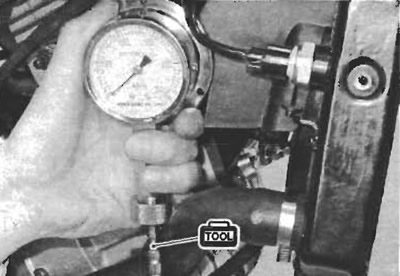The decision to overhaul the cylinder is often based on the results of a compression test. Periodic maintenance records kept at your dealership should include compression readings for each maintenance service.
Compression pressure specification (Automatic de-comp. actuated)
| Standard | Limit | Difference |
| 1300-1700 kPa 13-17 kgf/cm² 185-242 psi | 1100 kPa 11 kgf/cm² 156 psi | 200 kPa 2 kgf/cm² 28 psi |
Low compression pressure can indicate any of the following conditions:
- Worn-down piston or piston rings
- Piston rings stuck in grooves
- Poor seating of valves
- Ruptured or otherwise defective cylinder head gasket
Overhaul the engine in the following cases:
- Compression pressure in one of the cylinders is 1100 kPa (11 kgf/cm², 156 psi) and less.
- Difference in compression pressure between two cylinders is 200 kPa (2 kgf/cm², 28 psi) and more.
- All compression pressure are below 1300 kPa (13 kgf/cm², 185 psi) even when they measure 1 100 kPa (11 kgf/cm², 156 psi) and more.
Compression test procedure
Notes:
- Before testing the engine for compression pressure, make sure that the cylinder head bolts are tightened to the specified torque values and valves are properly adjusted.
- Have the engine warmed up by idling before testing.
- Be sure that the battery used is in fully-charged condition.
 |  |
Remove the parts concerned and test the compression pressure in the following manner.
Lift and support the fuel tank. (5-7)
Remove all the spark plugs. (2-6)
Fit the compression gauge in one of the plug holes, while taking care of the tight connection.
Keep the throttle grip in full-open position.
While cranking the engine a few seconds with the starter, and record the maximum gauge reading as the compression of that cylinder.
Repeat this procedure with an other cylinder.

- 09915-64512: Compression gauge
- 09913-10750: Adaptor
